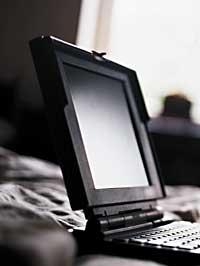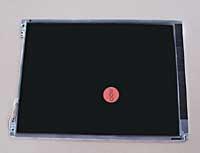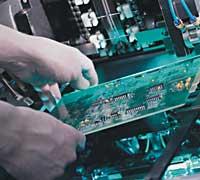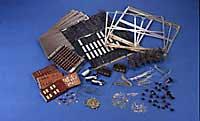What happens when liquid crystal displays are damaged?
2005/02/01 Kortabitarte Egiguren, Irati - Elhuyar Zientzia Iturria: Elhuyar aldizkaria

LCD letters ( Liquid Crystal Display ) do not represent the latest technological innovation. For thirty years liquid crystal displays have been extended to calculators, watches, television, digital cameras of photos and video, etc. until reaching the PCs. The initial problems of liquid crystal have been reduced rapidly, especially thanks to TFT (Thin Film Transistor) technology.
This uses the semiconductors instead of the electrodes to turn on and off each point of the screen, giving solution to resolution problems, viewing angle and color purity. Most current flat screens use this technology.
Characteristics of liquid crystal
The word crystal is a technical term, iron or steel are crystals and glass are not. Specifically, the word crystal represents a material of crystalline structure. Therefore, the name of liquid crystal is largely rare and quite counterposed. And it is that, in general, the crystal is something solid, ordered for most, and not disordered or liquid. However, as has already been indicated, experts have found that both characteristics are compatible in the same substance
...
Liquid crystal displays are much better than conventional cathode tubes in many fields. Among other things, the device occupies less space on the table, being flat the entire surface is visible and does not lose image in the corners, does not emit electromagnetic radiation and distortions are minor, since each point of the screen is watched as a pixel. But, how not, they are much more expensive.
Another characteristic feature of liquid crystals is its reaction with light, electricity, and temperature. This is because, among other things, the temperature modifies the properties of the liquid crystal. If the temperature is very cold, the liquid crystal is opaque and vice versa if the temperature is very hot.

Although we are gradually advancing and advancing in technology, we still have to work hard to answer some questions. For example, when these liquid crystal displays are damaged, what should we do, where to throw them or how to recycle them?
What to do with liquid crystal displays
Technological center GAIKER VI Europe. Participates in a project within the Framework Program. The ReLCD project aims, among other things, to reuse and recycle liquid crystal displays used in computers, electronic agendas, televisions and calculators.
On the one hand, the project is developing a methodology for verifying the operation of old liquid crystal screens (LCD) for the manufacture of new products with these products, and on the other hand the technologies necessary for their repair are being generated and looking for methods of detection of dangerous substances. Its objective is to develop an ecological and effective technology for the dismantling and recycling of screens out of use.

In addition, the project itself wants to launch a pilot plant for recycling liquid crystal screens, which incorporates improvements in both its design and its production for the creation of screens with less environmental impact.
The European directive on waste of electrical and electronic devices establishes that the surface screens above 100 cm 2 cannot be directly poured to the landfill, but must be managed previously. Below is an analysis of whether the LCD is well or deteriorated. In the first case it is used for its reuse and in the second the screen is decontaminated.
Liquid crystal displays contain dangerous substances, such as mercury lamps. Mercury is the list of the twenty most dangerous compounds that we can find both in industry and in our homes. In this sense, the European directive on waste of electrical and electronic devices establishes that it must proceed to its immediate disposal and treatment by a waste manager.
Mercury is not the only dangerous substance that these displays contain. Circuit boards, metals, methacrylate screen, plastic frames, gums, etc should also be considered. There are two possibilities to take advantage of the latter: on the one hand, the treatment and recycling of these waste or, on the other, its direct deposit in special warehouses.
It is expected that by 2005 there will be 40,000 tons of liquid crystal screen waste in the world and 2 million tons of electric-electronic waste in its vicinity.
www.ihobe.net

Gai honi buruzko eduki gehiago
Elhuyarrek garatutako teknologia





